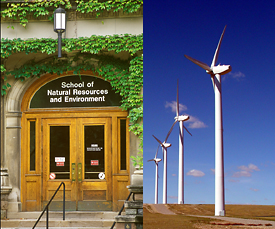U-M recently contracted with Renewable Choice Energy to provide all of the energy used by the School of Natural Resources and Environment (SNRE) at the S.T. Dana Building during a two-year period.

“We are committed to sustainable building practices by purchasing energy from this renewable source,” says Dean Rosina Bierbaum. “This purchase prevents 746,947 pounds of CO2 pollution—the equivalent of taking 65 cars off the road or planting 102 acres of trees.”
This energy will be generated at a renewable wind “farm,” decreasing harmful pollutants and lessening the dependence on fossil fuels. This new purchase will provide 536,600 kWh of power for the Dana Building.
Using wind power is an important aspect of operating a sustainable building, Bierbaum says. According to the Environmental Protection Agency, the conventional way electricity is produced, primarily by burning fossil fuels, is the leading cause of industrial air pollution. Wind power offers a clean, cost-effective alternative.
Wind power was purchased as part of a comprehensive plan that is intended to lead to gold certification by the Leadership in Energy and Environmental Design (LEED) Green Building Rating System. LEED is a voluntary national standard for developing high-performance, sustainable buildings. Based on scientific standards, LEED emphasizes state-of-the-art strategies for sustainable site development, water savings, energy efficiency, materials selection and indoor environmental quality.
Wind power produced by Renewable Choice Energy will exceed all of the energy purchased from the commercial power grid for the S.T. Dana Building. Each year the University generates about twice as much power as is purchased from the commercial electricity grid. The University of Michigan Central Power Plant produces power utilizing a process called cogeneration. (Cogeneration involves simultaneous production of both useful steam and electricity, and is a major contributor to energy efficiency and reduced air pollution on Central Campus.) For more information about cogeneration, see http://www.p2000.umich.edu/energy_conservation/ec4.htm. Wind power produced by Renewable Choice Energy will be equivalent to half of all energy used by the School of Natural Resources and Environment at the S.T. Dana Building.

